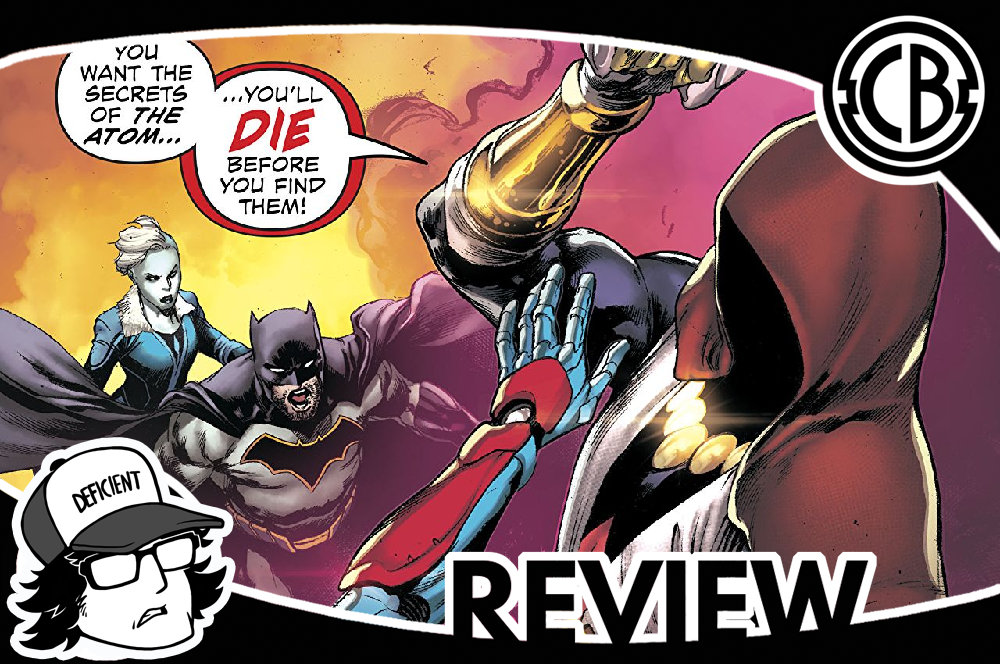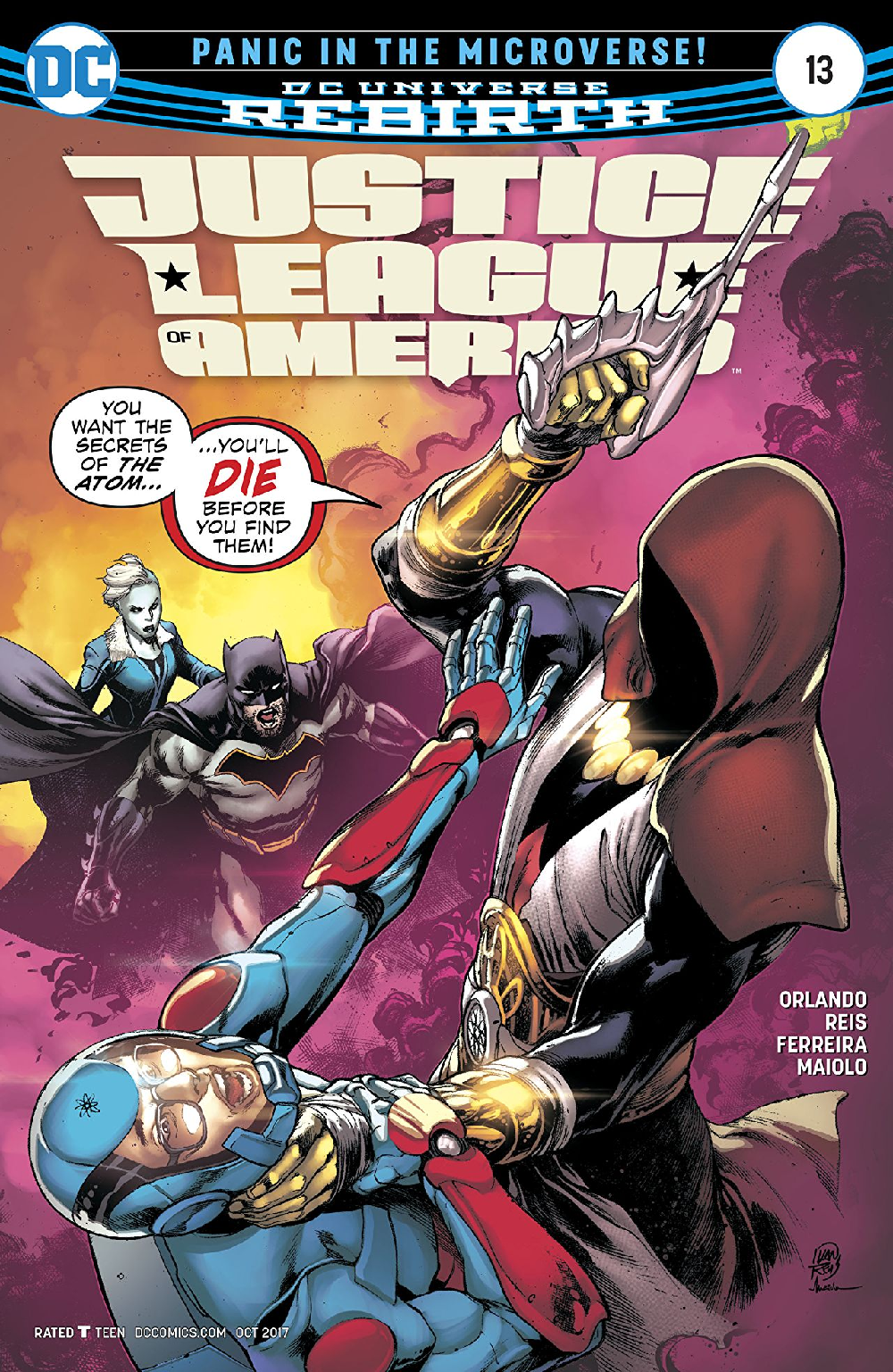Review: Justice League of America #13
By Jonathan Edwards
Let's hit the ground running with this review; after finally straightening itself out so that its greatest sin was just being boring last issue, Justice League of America immediately missteps right back into the world of excessive, clunky exposition and underdeveloped concepts. I wish I could say I'm surprised, but I'm really not. I figure me not being surprised by that is itself not that surprising to anyone who's read at least one or two of my prior JLA reviews. But come on, no shit that wasn't Ray Palmer at the end of the previous issue, and now you're going to start off with multiple pages of exposition, completely forced and contrived conflict between Ryan, Lobo, and Killer Frost, and then you're going to cut away back to Black Canary and Ray fighting Afterthought? Well, at least that last bit was the only cutaway in the whole issue, and it's actually managing to build a slight amount of intrigue. However, the fact remains that it takes until a third of the way into this issue for the main plot to actually start progressing again. But even once it does, more exposition bogs it down, and then the issue is over without much else happening.
One of the biggest problems with this story arc is that the Microverse still just isn't very interesting. It's a dime a dozen alien planet and/or high fantasy setting. Seriously, Preon is just a Microversal elf, and no, calling her species "Docent Folk" is not a subtle nor clever hint. Furthermore, apparently a fucking sorcerer was involved in creating Moz-Ga, the thinking planet. That or Moz-Ga was the sorcerer and he became the planet or something? I don't know. For all of the exposition, that part wasn't explained all that well. Regardless, it can also grant wishes, is stupid, and did they really not have any other ideas for how to depict the Microverse? Why not go for something that, I don't know, feels fundamentally different than the world our heroes just came from? Additionally, the more characters talk about the Microverse, the more it seems that dialog is just wasting time. At one point Preon states "the Microverse is vast and not completely mapped," and I immediately found myself thinking "yeah, why the fuck would it be?" I mean, am I wrong in presuming that the Microverse spans the entirety of the normal universe, thus meaning it would have to be literally infinite amounts larger? Then, there are the Quantum Storms, and they're pretty much exactly what they sound like. It's lightning that also alters/destroys reality. I'm really not sure how that's supposed to work, if it's supposed to be real electricity or just look like it, or if the "Ignition Point" of the storms is meant to be connected to the bigger meta-narrative of the post-New 52 DCU. But, there are two things I do know. One, they mention "Quantum Storms" so many times by the end of the issue that the name loses all meaning. And two, Lobo better be fucking dead after he got hit by one of them, or everything we've learned about them is a bunch of bullshit. (Spoiler: he's definitely not going to be dead, and it will be bullshit).
Now as much as I've complained about JLA's tendency to tell rather than show in the past, some of the exposition we get here is just kind of baffling. For example, when Preon is talking about that aforementioned "Ignition Point," she first explains what it is pretty concisely as the origin of the Quantum Storms. Cool, got it. And then, in the very next speech bubble in the very next panel, she explains it again but in a slightly different way. It might seem small, but it stuck out like a huge fucking sore thumb while I was reading. It added nothing and iss symptomatic of just how overwritten this issue really is. But, the truly egregious exposition happens when Aron Aut shows up. I don't know if it's the real guy or someone who just took his name, but I'm like 90% sure he's the bad guy either way. Aside from his counterexplanation of what "really" happened between him, Ray Palmer, and Preon being overly elaborate (and full of plot convenience if it does turn out to be true), it also raises a question: if Preon really is a baddie, what was her motivation for telling the JLA about Aron Aut in the first place? She could have easily lied and said she was the only one working with him so that, in the event Aron showed up, the JLA wouldn't know who the hell he is and have no reason to believe him. This is what tells me that Aron's the real bad guy. Or, Steve Orlando has a compulsion to spoon-feed readers bad exposition even when it conflicts with the character's motivations.
Despite having already done art for this book several times, Ivan Reis work caught my eye a bit more this time around. I couldn't tell you exactly why, but I think it's safe to say that JLA always looks the best when it's in Reis's hands. Well, mostly. There's the problem I mentioned last time of the aliens looking kind of generic, and I'm not a big fan (or a fan at all, really) of Preon's design. Yet, for some reason Aron's worked well enough for me.
This isn't the worst that Justice League of America has ever been, but it ain't all that good either. Ultimately, I feel like it'll only reach one of two potential eventualities. Either it'll finally find its footing after months and months of trial and error and finally start making strides in a positive direction, or it'll go the much more likely route of becoming little more than a homogenized entropic mess, making the exact same mistakes in the exact same way in every issue. And at that point, I'll just stop reviewing it.
Score: 2/5
Justice League of America #13
DC Comics


